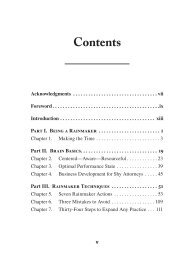(Bk Business) Carol Kinsey Goman Ph.D.-The Nonverbal Advantage_ Secrets and Science of Body Language at Work -Berrett-Koehler Publishers (2008)
Just
Just
You also want an ePaper? Increase the reach of your titles
YUMPU automatically turns print PDFs into web optimized ePapers that Google loves.
Chapter 4: Face to Face<br />
61<br />
TRY THIS<br />
For a full day, pay <strong>at</strong>tention to different emotions th<strong>at</strong> are<br />
being expressed by your co-workers or clients. As soon as you<br />
see one, write it down. Now here’s the hard part: just write the<br />
emotion you detect, not the cause: “She looks sad,” not “She’s<br />
disappointed with the present<strong>at</strong>ion.” “He looks fearful,” not<br />
“He’s afraid we’ll lose the account.” “<strong>The</strong> boss looks angry,”<br />
not “<strong>The</strong> boss is mad <strong>at</strong> me for coming l<strong>at</strong>e to the meeting.”<br />
Omitting the suspected motiv<strong>at</strong>ion is difficult to do<br />
because we all have a tendency to jump to conclusions<br />
about the causes behind expressions. I’m not saying<br />
th<strong>at</strong> your assumptions about causes are wrong, just<br />
th<strong>at</strong> they may be. And this gives you a chance to<br />
stop, observe, <strong>and</strong> then explore altern<strong>at</strong>ives.<br />
Universal Expressions<br />
A longst<strong>and</strong>ing deb<strong>at</strong>e involved the origins <strong>of</strong> various facial<br />
expressions. On one side <strong>of</strong> the argument was Charles Darwin,<br />
who had written in 1872 about the consistency <strong>of</strong> expressions<br />
in mammals. On the opposing side were prominent social<br />
scientists <strong>of</strong> the 1960s <strong>and</strong> 1970s—including anthropologist<br />
Margaret Mead—who believed th<strong>at</strong> facial expressions are<br />
learned through culture. So, who was right? Are facial expressions<br />
inn<strong>at</strong>e or are they culturally influenced?<br />
<strong>The</strong> issue was settled by Paul Ekman, <strong>Ph</strong>D, a pr<strong>of</strong>essor <strong>of</strong><br />
psychology <strong>at</strong> the University <strong>of</strong> California <strong>at</strong> San Francisco<br />
(UCSF). His research proved th<strong>at</strong> there are six expressions<br />
th<strong>at</strong> are universally recognized <strong>and</strong> understood: joy, sadness,<br />
surprise, fear, contempt/disgust, <strong>and</strong> anger.




